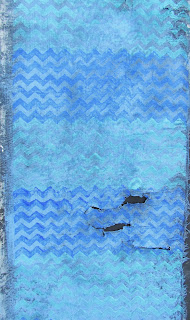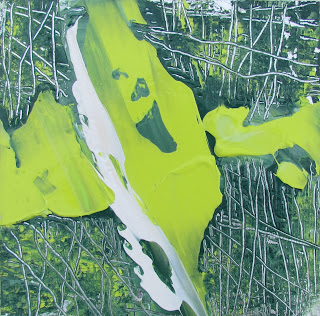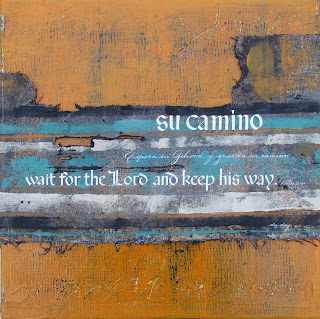 |
| (draft 1) |
The Spanish word for peace is "paz". The quote you will see in the final is from Psalm 29:11. There is nothing quite like soothing blue colors to capture the spirit of "peace".
The previous couple of postings with a tighter weave (muslim) did not yield great results. That piece of fiber is now in the garbage and I returned to my lightweight linen type fiber with a looser weave. And for those who say..."You could have saved it; why did you throw it in the trash?"....that is not always true.
To create these very textural kinds of looks by deconstructing fiber, it is very important to have a fiber that is deconstructable. Otherwise, you can "beat a dead horse", but it will not be revived. It's dead!
So I began this piece with black gesso on one side and allowed it to dry thoroughly over the weekend. This morning I sanded it, and the deconstruction yielded some nice frayed areas and a few holes. And that is excellent, because I plan to adhere silver leaf to the area of the support where this will be placed and that silver will come shining through.
The next step was to spray the fiber with Palette Wetting Spray (Liquitex). The spray is different than simply spraying water because it consists of a polymer emulsion that is designed to keep the acrylic paint wet for a longer period of time, but it also helps blending and moving the paint around. (I have found that "chip brushes" are the very best brush for applying fluid acrylics to fiber.)
The mixture used for this base color was Cobalt Blue, a bit of Raw Umber, and a lot of White. (Fluid Acrylics) This dilute color causes a color vibration with the more intense colors stamped over this background. Cobalt Blue (straight from the bottle) and Cobalt Turquoise + White are the colors of the chevron pattern. (Color was brushed onto the stamped with a chip brush.)
And just in case you haven't noticed, chevron patterns are the rage right now. So let me take this opportunity to give a "shout out" for my daughter Alice, who is creating some fabulous wrist bags and tote bags, and also makes custom t-shirt quilts.
Check out her products at http://www.etsy.com/shop/ChevronBagsUnlimited. And there you have it...just a few more things to think about.





.jpg)
.jpg)













.jpg)









